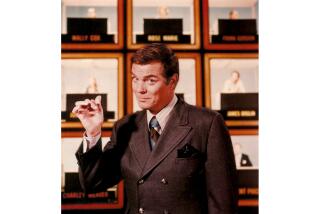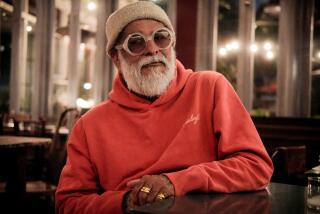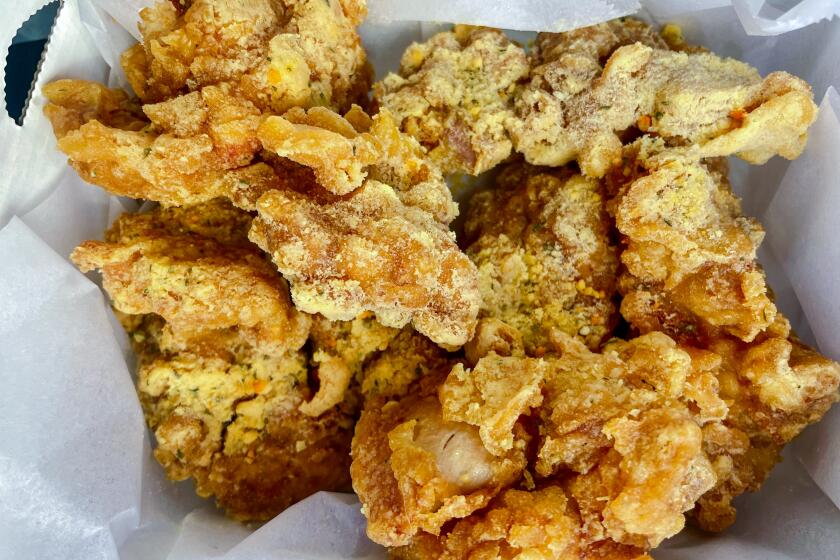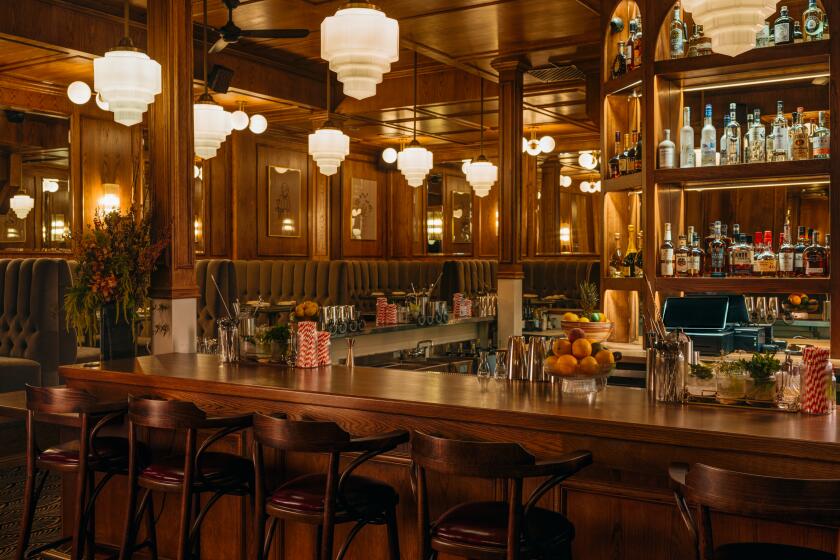TV Chef Julia Child Dead at 91
Julia Child, the influential cooking instructor whose books and television shows demystified French cuisine and launched an enduring epicurean craze in America, died this morning at her apartment in Montecito. She was 91.
Child, a longtime Cambridge, Mass., resident who moved back to her native California in 2001, had been in generally good health, visiting farmers markets and eating out several times a week, until a month ago, when she began suffering from kidney failure. She passed away in her sleep after a last meal of French onion soup prepared by her longtime assistant, Stephanie Hersh.
Literally a towering figure in the culinary world, the 6’2” Child started a revolution in the kitchen in 1961 when she published, with co-authors Simone Beck and Louisette Bertholle, “Mastering the Art of French Cooking.” With more than one million copies sold and a 40th anniversary edition published in 2001, it is still considered the definitive classical French cookbook in the English language.
She went on to blaze trails on public television, where her cooking shows have charmed and educated millions.
“She was the grand dame of cooking,” cookbook author Marion Cunningham told The Times today. “She brought more people to the kitchen that had never thought of going into the kitchen. She has never been matched on television. She was humorous. She could just arrest your attention. Whatever that magic is, she had it, and it is so rare.”
A self-described ham, Child promoted “Mastering” on a Boston educational television station and wound up with her own show, “The French Chef,” in 1963. Captivating audiences with her merry patter, often klutzy maneuvers and down-to-earth attitude about a cuisine that had been too haute for the masses, she became public television’s first bonafide star.
By the late 1970s, Child was an American icon, ripe for parody. In a classic “Saturday Night Live” skit, comedian Dan Ackroyd blew large her foibles, showing her blithely chattering about chicken giblets and livers despite chopping off her finger and drenching the kitchen in blood. Throughout the piece, Ackroyd trilled and warbled in the distinctive falsetto that millions of Americans instantly recognized.
Delighted by the spoof, Child was the first to admit that cooking was often messy and its results imperfect. But that was part of the fun.
One time, she accidentally flipped a potato pancake onto the floor. She pulled a souffle from the oven that promptly collapsed. And, after struggling mightily to carve a roast suckling pig, she set down the knife, rested her hands on the table and, looking straight into the camera, admitted defeat. But, reminding audiences that “you are alone in the kitchen and no one can see you,” Child just sailed the dishes to the table as if nothing was amiss. “Never apologize” was her steadfast rule.
Along the way, Child introduced Americans to the tools of good cooking and to a bounty of unfamiliar foods, launching stampedes to kitchen supply stores and supermarkets for copper bowls and wire whisks, goose liver and leeks.
“She made mistakes in the kitchen. But by making them and fixing them, she made everyone realize that’s OK.” Said Sara Moulton, a former prep cook for Child before becoming executive chef of Gourmet magazine and a cooking-show host on the cable Food Network. “She took away the fear of cooking.”
Her 90th birthday in August 2002 was celebrated by foodies at parties around the country, including at Copia, the wine and food museum in Napa, Calif., that named its centerpiece dining room Julia’s Kitchen. The occasion also was marked by a display of Child’s old Cambridge kitchen, reassembled at the Smithsonian’s National Museum of American History in Washington, D.C.
Pro-butter, pro-salt, pro-fat, and pro-red meat in moderation, Child prided herself as the loyal opposition of “food terrorists,” believing their alarms about cholesterol, calories and contaminants would deprive the palate of joyful tastes. She crusaded against the minimalist tendencies of nouvelle cuisine for years.
In Julia Child’s world, cooking and eating were, above all, about having a good time.
“I can remember eating with her in the great, three-star restaurants of France. She would just dig into food, swab her plate with a piece of bread. Julia believed food should be enjoyed. If there was any one lesson of Julia’s, that was it,” said chef Patrick Healy.
Her love of gastronomy was not bred at home. Born Aug. 15, 1912, Julia McWilliams was the oldest of three children of a patrician Pasadena family who remembered the kitchen of her youth as “a dismal place.” Her parents employed a series of cooks who turned out the standard meat-and-potatoes fare of the day. On the cook’s night off, Julia’s mother took over but her efforts were not inspiring: baking powder biscuits, codfish balls and welsh rarebit were mainstays. Fortunately, Julia had the “appetite of a wolf” and was always hungry.
She attended private schools-Polytechnic in Pasadena, Katharine Branson School for Girls in Mill Valley, and Smith College, her mother’s alma mater. Less a scholar than the life of the party, she graduated college with a C average, then returned to Pasadena where she tried to immerse herself in the rituals of her social class: joining the Junior League and finding a husband.
Her height was a disadvantage in the dating game. So, with thoughts of being a novelist, she went East, where she got a job writing advertising copy for W.J. Sloane in New York and had some pieces published in the New Yorker.
When she was 25, her mother died, and she came home again. She dated Harrison Chandler, whose father Harry was publisher of the Los Angeles Times, but turned down his proposal of marriage. She was searching for meaning in her life, she told her biographer, Noel Riley Fitch. World War II helped her find it.
Too tall to join the military, she moved to Washington in 1942 and found a job as a typist in the War Information Office. Then she became a researcher in the Office of Strategic Services, the precursor of the CIA, where one of her jobs was to develop a shark repellent to protect airmen downed at sea. When the OSS wanted to open a branch in India, Julia volunteered.
The branch headquarters was a tea plantation in Ceylon (now Sri Lanka). On May 1, 1944, out on the veranda, she met Paul Child, an artist turned mapmaker for the OSS who was 10 years her senior. They couldn’t have been more different.
“He had lived in France and I’d only been to Tijuana,” she told Fitch, “and he was also an intellectual. I was a kind of Southern California butterfly, a golf player and tennis person who acted in Junior League plays.”
But they became good friends in India, and grew even closer in Kunming, China, their next posting, where they relished excursions to local restaurants. (Chinese food would become her second favorite cuisine, after French.) Paul Child was a passionate gourmet who introduced Julia to a world where food was not merely nourishment but a sensual experience.
To capture his heart, Julia knew what she would have to do: She had to learn to cook.
Back in the States after the war, she enrolled in the Hillcliff School of Cookery in Beverly Hills. When Paul Child came to visit, she cooked him calves’ brains in red wine sauce but the results were disastrously mushy. Later she would say that Paul “married me in spite of my cooking.”
They were married on Sept. 1, 1946 and settled down in Washington D.C. for a few years. In 1948, Paul got a job as an exhibits officer for the United States Information Service in Paris. He had lived in Paris during the expatriate era of the 1920s and knew France intimately.
En route to Paris from Le Havre, the Childs stopped in Rouen for lunch. Julia’s meal-oysters Portugaises on the half shell, sole meuniere browned in Normandy butter, a green salad, creme fraiche and cafe filtre-was epiphanal.
“It was just divine food,” Child recalled decades later. “I never got over it. The whole experience was just something new and beautiful.”
She signed up at a Berlitz school to amplify her college French. Then she registered at Le Cordon Bleu, the renowned school of French cooking. She was the only woman in Chef Max Bugnard’s class for ex-GIs who wanted to become professional cooks. At 37, she discovered that she “really knew just about nothing” about cooking.
“I’d never made a real cake before,” she said. “I’d never made mayonnaise.” Suddenly, she was skinning orange segments for canard a l’orange, rolling out dough for quiche lorraine, and mashing potatoes into white sauce for gnocchi a la florentine. From the moment she enrolled, Paul Child became a “Cordon Bleu widower” who could not pry his wife loose from the kitchen day or night, “not even with an oyster knife.”
In 1951 Child met a woman named Simone Beck, who introduced her to an exclusive gastronomic society for women known as Le Cercle des Gourmettes. Beck had a friend, Louisette Bertholle, with whom she had written a slim French cookbook for Americans. Stymied in their attempts to get it published, they were advised by their editor to find “an American who is crazy about French cooking” to collaborate with them. Child enthusiastically embraced the role. Believing most cookbooks failed to give enough detail, she said, “I thought we could really do something to explain French cooking to America.”
Instead of plunging into the book, however, the three women decided to open their own cooking school first. Called L’Ecole des Trois Gourmandes, the school held classes at $5 a lesson in the Childs’ Left Bank apartment.
Work on the cookbook began in earnest in 1952. Beck developed the recipes, while Child translated them into readable English. But Child wound up doing far more. When Beck sent her a recipe, Child tested it until it was foolproof. Bertholle would add some flourishes, then Child would write the final version.
It was Child’s idea to break recipes down into do-ahead steps, an innovation that kept the busy American housewife in mind. She also adjusted the instructions to accommodate American-sized portions and supplies available in American supermarkets.
She hated the skimpy directions offered in most American recipe books. A typical recipe for chicken, for instance, said to spread butter on the carcass and broil for 20 minutes, by which time, Child observed, “it was burning.”
Her recipes were deliberately voluminous. Beating and folding egg whites alone took up four pages of clear and precise instructions describing the strokes per second, the hand motion, even which part of the arm and wrist to employ. There were 50 pages on sauces, another 50 on poultry, 100 on vegetables. (The longest recipe appeared in Volume II of “Mastering,” published in 1970, which took 22 pages to explain how to make French bread.) If a book could hold a nervous cook’s hand, describing what a dish should look and feel like at every step, “Mastering” did.
“She was one of the first authors to express the pure sensuous pleasure in creating a dish,” her editor, Judith Jones, told Bon Appetit in 2002. “She wallowed in the lushness of the ingredients.”
It took 10 years to complete the tome, with drafts typed on onion skin paper and carbon copies mailed back and forth from wherever the Childs had been assigned-Oslo, Norway, Marseille, Bonn. When at last the authors delivered a 700-page manuscript, Houghton Mifflin rejected it, pronouncing it “utterly unpublishable.” But Alfred A. Knopf, himself a gourmet, recognized its value and quickly scooped it up, even though he mainly published fiction.
In 1961, when Child was 49, her public career was launched.
“I was sure it was revolutionary,” Jones said years later. “It was like having a teacher right there beside you in the kitchen, and everything really worked.”
Craig Claiborne, then the food editor of the New York Times, called the book “monumental . . . what may be the finest volume on French cooking ever published in English.”
Although Claiborne, James Beard and others also were laboring to refine the American palate (pre-Child, the most popular cookbooks in the U.S. had titles like “The Can Opener Cookbook” and “10-Minute Meals”), “Mastering” created the new standard. People cooked their way through it, chapter by chapter. Said Beard, “I only wish I had written it myself.”
Although Beck and Bertholle are listed as equal co-authors, Child was responsible for the book’s elegant language and painstaking detail.
“This is a book for the servantless American cook who can be unconcerned on occasion with budgets, waistlines, time schedules, children’s meals, the parent-chauffeur-den mother syndrome, or anything else which might interfere with the enjoyment of producing something to eat,” it began. “Written for those who love to cook, the recipes are as detailed as we have felt they should be so the reader will know exactly what is involved and how to go about it. This makes them a bit longer than usual, and some of the recipes are quite long indeed.”
The book did not win raves from everyone. The New Yorker, for instance, took the authors to task for blessing the use of canned salmon and broth, among the book’s few bows to the American god of convenience.
“The idea was to take French cooking out of cuckoo land and bring it down to where everybody is,” Child once said. “You can’t turn a sow’s ear into veal Orloff, but you can do something very good with a sow’s ear.”
The success of the book led in fairly short order to television. Invited to appear on a book review program on WGBH-TV, Boston’s educational television station, Child brought along a copper bowl and a giant wire whisk and proceeded to show viewers how to whip egg whites. “Who is this mad woman cooking an omelet on a book review program?” producer Russell Morash, Child’s future producer and director, thought the first time he saw her.
The station received 28 letters asking for more cooking demonstrations; for public television, this made it a hit. Child was offered a chance to make three pilots. Dubbed “The French Chef,” the first show, on making a French omelet, aired on Feb. 11, 1963.
The timing was fortuitous. The Kennedys were in the White House and had installed a French chef. More Americans were traveling to Europe and returning with new tastes. A generation of nascent foodies tuned in for instruction, but soon others followed, entertained by the droll mistress of cuisine bourgeoise.
One time the show opened on a boiling pot of water shrouded by a piece of cheesecloth. Suddenly Child was in the picture, lifting the cheesecloth and inquiring, “What’s cooking under this gossamer veil? Why, here’s a great big, bad artichoke, and some people are afraid of it.”
She appeared in a pith helmet and fired a popgun to snare a squab for an installment on “Small Roast Birds.” She donned a raincoat and umbrella to dry lettuce with a salad spinner. She deftly deadpanned one-liners. “I have a self-cleaning floor,” she once remarked after dropping potato peelings on hers. Afterwards, several people wrote in asking where they could purchase their own self-cleaning floor.
There was no re-taping to cover up goofs or dishes gone awry. Many viewers tuned in “to see just what rule of gastronomic or television decorum Julia might break tonight,” food historian Robert Clark once observed. Her antics not only inspired the Saturday Night Live crew but a light opera in 1991 called “Bon Appetit,” which starred Jean Stapleton as Child.
The cooking program was broadcast from 1963 to 1966, went on hiatus while Child worked on the second volume of “Mastering,” then returned for another run from 1970 to 1973. In 1965, it won a Peabody. In 1966, it earned public television’s first Emmy.
More than two decades after the last show was filmed, the series remained a hot property for PBS and cable. The Television Food Network broadcast Child marathons on Thanksgiving Day.
Child made six other television shows, including “Dinner at Julia’s,” “Baking with Julia,” “Julia Child and Company,” and “Julia Child--Cooking with Master Chefs.” Most were accompanied by cookbooks.
One of her last cookbooks reflected changing tastes and technologies of the 1980s. Called “The Way to Cook,” it encompassed more dishes thought of as American, endorsed the use of such tools as the food processor, and was more health conscious, suggesting reductions of fat here and there.
She was criticized over the years for favoring food that padded the hips while depleting the pocketbook. “Take Julia Child off the air,” one unhappy viewer complained years ago. “No more of her expensive recipes from Mars with a gallon of booze.” Some viewers thought booze was the reason for Child’s looniness, an accusation that Child dismissed as pure bunk.
She never gave in to the critics whom she accused of fanning fear of food. Nor did she sanction the products marketed to the fat-conscious that she called “fake food”: “I, for one, would much rather swoon over a few thin slices of prime beefsteak, or one small serving of chocolate mousse, or a sliver of foie gras than indulge to the full on such nonentities as fat-free gelatin puddings,” she wrote in the introduction to the 1989 book. “In spite of food fads, fitness programs, and health concerns, we must never lose sight of a beautifully conceived meal.”
To further the appreciation of gastronomy for amateurs and professionals alike, she helped found the American Institute of Wine and Food with vintner Robert Mondavi in 1981. She donated 2,500 books, papers and manuscripts--the largest collection of cookbooks in the country--to the library of gastronomic literature at the Schlesinger Library at Harvard University and Radcliffe College.
Although bent with age and walking with a cane, she still had the stamina to tape a new show, with master chef Jacques Pepin, when she was 85, and went on the road to promote it and the accompanying book. By then, Paul Child, the man for whom she donned her signature blue apron and took to cooking in earnest, was no longer by her side. Her collaborator, manager, sous-chef and dishwasher, who also provided many of the photographs and drawings that illustrated her bestselling guides, died in 1994 at the age of 92. The couple never had children.
The woman who considered her paramount life goals to be “marrying a nice man and cooking nice food” said Paul Child’s death took some of the fun out of being the doyenne of American home cuisine. But retirement had no appeal, either.
In late 2001, Child closed the rambling, three-story house in Cambridge that she had shared with her husband for 40 years and moved permanently to a compact apartment in a planned community in Santa Barbara, where they had spent their winters. She donated most of her Cambridge kitchen to the Smithsonian, sending her French copper pots to Copia and keeping a few small no-stick frying pans and her favorite heavy-duty kitchen shears for whipping out a hamburger or a crepe.
Her new kitchen was about the size of a boat galley and could only seat six.
Yet, “I never feel lonely in the kitchen,” she told Time magazine recently. “Food is very friendly. Just looking at a potato, I like to pat it. There’s something so pleasant about a big baking potato or a whole bunch of peas in their shells. . . . To me, the kitchen has never stopped being a place just full of possibilities and pleasures.”
More to Read
Eat your way across L.A.
Get our weekly Tasting Notes newsletter for reviews, news and more.
You may occasionally receive promotional content from the Los Angeles Times.











